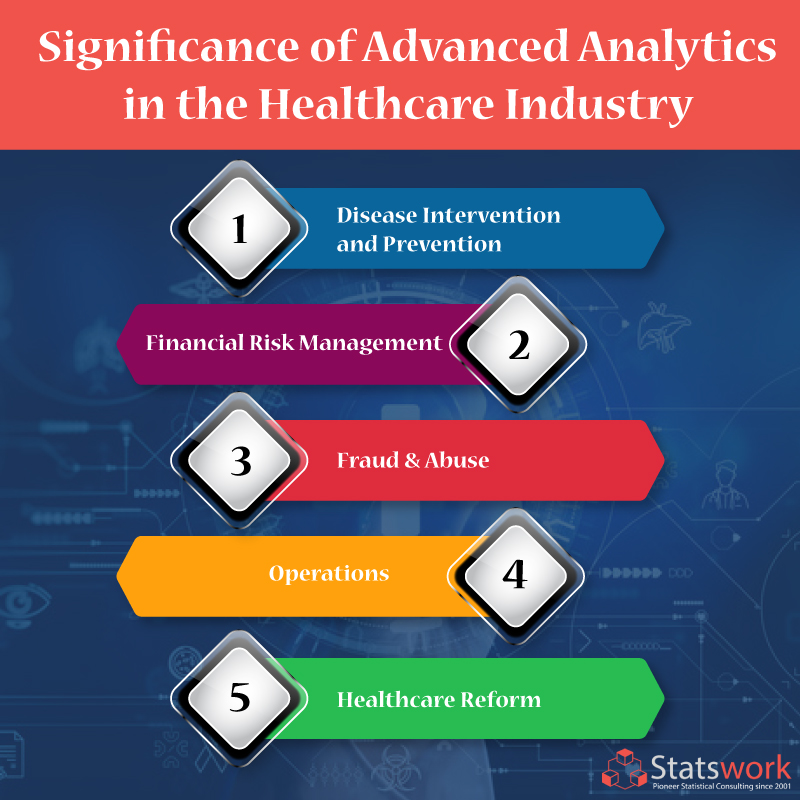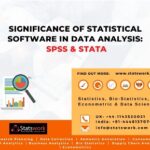Significance of Advanced Analytics in the Healthcare Industry
In-Brief
- Online survey data analysis services assist analysts in comprehending the direction of infectious diseases (through the GPS coordinates obtained from the cell phone).
- With the support of healthcare data analytics using Python, clinicians can forecast the precise treatment plan or mortality based on the EHR data.
- For example, Google’s Deep Learning and Machine Learning algorithm enable detecting cancer in patients using their medical data and history.
Introduction
The Healthcare data management approach is the process of analysing huge data gathered from several resources. It supports healthcare administrations to examine their patients holistically, which offers enhanced health outcomes and personalized treatments. The healthcare marketplace has become aggressively competitive and complex, and it gets more complex day by day.
To extract value from data, effective tools and methods are needed. The market’s technology will help you make better choices that contribute to enhanced healthcare outcomes by gathering the data coming in. Organizations are receiving enough data to help them understand what patients need.
The Role of Analytics in Transforming Healthcare
Healthcare agencies throughout the United States have started to implement technology such as PACS imaging systems, Telemedicine Services, and EMRs (Electronic Medical Records) and try to make sense of the vast amounts of data that flow through the system (both structured and unstructured). Consequently, it’s crucial to understand what methods can extract knowledge from data to generate value and benefit from operational, financial, and clinical insights.
Genome analysers and other analytics tools on the market can help decipher the facts and remove unnecessary/unneeded information to remove just what is required. As a result, the patient’s health conditions are improved. The knowledge obtained from different sources can be used in several ways by healthcare organizations. Our statistical data analysis services help in collecting quality data which help in making a better decision.
1. Disease Surveillance and Preventative Management
Healthcare analysts work carefully on the gathered data that’s offered to them. As a result, they look for trends in structured and unstructured data, including data that is readily accessible on non-traditional platforms such as social media posts, text messages, and the like. They take all of the data and turn it into actionable lessons to enhance health outcomes.
The extensive use of mobile devices has also aided in this regard. Online data analysis service helps analysts in comprehending the direction of infectious diseases with the help of GPS.
The process of converting and using the data involves the following:
Examine the trends in the data and keep an eye out for any disease outbreaks. Caregivers would be able to offer treatments and even respond to medical emergencies based on detailed analysis. Develop preventive strategies, medications, and vaccinations based on the analyzed results.
In the past, disease management was difficult due to a lack of timely data, fragmented databases that couldn’t be combined, and a lack of experts with computational backgrounds who could assist with epidemic planning, control, and response. The problems and epidemics can be tracked using big data analytics.
Genome sequencing, for example, generates massive amounts of big data, which can be used and run powerful analytics to track how microbes mutate in real-time during an outbreak. Nexstrain is a tool that allows users to share and monitor genome sequences as they occur to avoid and manage outbreaks.
2. Develop More Effective Diagnostic and Therapeutic Techniques
The benefit of healthcare informatics and predictive analytics:
- Create personalized wellness services customized to the needs of patients, helping them experience better health.
- Identify ineffective programmes and procedures that do not produce the desired results and eliminate them. Only outcome-oriented programmes are kept in the wellness programme packages as a result of this. All of the others have been excluded from it.
- When forecasting patient outcomes, the analytics will consider the most current medical studies from both peer-reviewed journals and databases.
- Artificial intelligence is often employed in developing an output profile (algorithms) based on data gathered from previous patients. This approach is used to construct a prediction model. This method is then used to assist new patients in receiving a new diagnosis.
3. Generating Faster, Leaner, and More Productive R&D Pipeline
It is difficult to get medication to a patient. The process of developing a drug, putting it through extensive clinical trials analysis, and eventually receiving FDA approval is lengthy and daunting.
Before giving medicines to patients, every pharmaceutical company and healthcare provider must go through this process thoroughly. To minimize the time a drug spends in the R&D pipeline, businesses use predictive modelling, computational methods and algorithms, and healthcare analytics.

The advantages are stated below:
Advanced analytics are critical for creating a low-attrition, leaner, quicker, and more efficient R&D pipeline and looking for ways to speed up the drug discovery process to improve patient wellbeing—experiment with procedures to avoid clinical trial failures and improve patient recruitment.
The Value of Analytics
Disease Intervention and Prevention
Data analysis services for statistics always go hand in hand with disease prediction and prevention techniques. This way, organizations would recognize patients at high risk of contracting chronic diseases early on and provide them with improved outcomes, preventing them from having to deal with long-term health issues.
Financial Risk Management
Financial risk management relies heavily on artificial intelligence. The biggest financial obstacle in the fee-for-service to success contract model, according to a study by Hospitals & Health Networks, is that assessing patient outcomes and deciding payment takes a long time.
Fraud & Abuse
Data and analytics may assist in the detection of fraud and violence. In healthcare, fraud can take many forms, ranging from honest errors like incorrect billings to needless medical tests, false statements that result in improper payments, and so on.
Big Data helps determine the patterns that lead to potential patterns of fraud and abide in healthcare insurance.
Operations
The use of technology in healthcare has gradually increased as a decision-making tool. It helps in making crucial operational decisions with enhanced technical infrastructure and proper data analysis.
Healthcare Reform –
Health organizations will use analytics to push healthcare initiatives, resulting in significant payment restructuring. It is effective enough to trigger major changes in the existing hospital-centric delivery model by forcing it to offer value rather than volume and results rather than activities.
Conclusion
Big data and predictive analytics help in the decision-making process, resulting in more motivating partnerships between providers and patients. It is critical to foster long-term constructive involvement, avoid readmission wherever possible, and lower chronic disease risks. Organizations can predict infections, avoid epidemics, and lower mortality rates by observing and analyzing structured and unstructured data. It’s simple to provide proactive treatment to patients when artificial intelligence, data processing, and machine learning IoT are combined.
References
- Srinivasan, U., & Arunasalam, B. (2013). Leveraging big data analytics to reduce healthcare costs. IT professional, 15(6), 21-28.
- Bose, R. (2009). Advanced analytics: opportunities and challenges. Industrial Management & Data Systems.



 Previous Post
Previous Post Next Post
Next Post